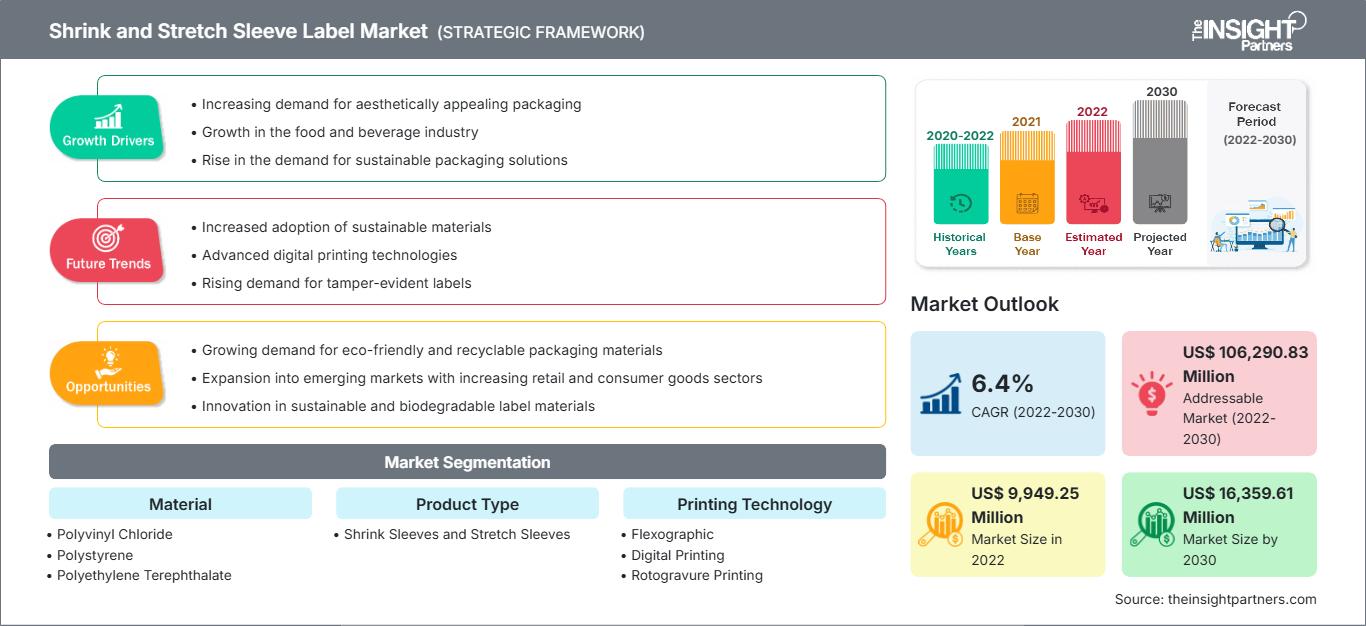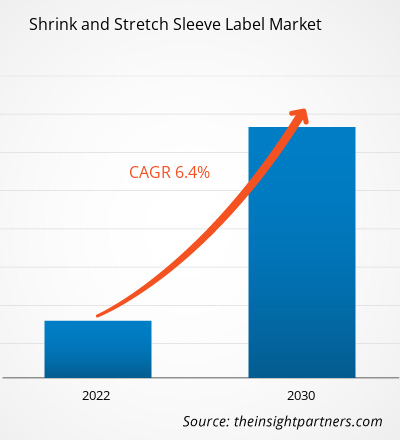[연구 보고서] 수축 및 스트레치 슬리브 라벨 시장 규모는 2022년 99억 4,925만 달러로 평가되었으며, 2030년까지 163억 5,961만 달러에 이를 것으로 예상됩니다. 2022년부터 2030년까지 연평균 성장률(CAGR)은 6.4%에 이를 것으로 예상됩니다.
시장 분석
스트레치 및 수축 슬리브 라벨 시장은 변화하는 소비자 선호도, 기술 발전, 그리고 지속 가능한 포장 솔루션에 대한 집중으로 인해 역동적인 환경을 반영합니다. 포장 산업이 지속적으로 성장함에 따라 시각적으로 매력적이고 정보를 제공하는 라벨에 대한 수요가 늘어나 스트레치 및 수축 슬리브 라벨의 채택이 증가하고 있습니다. 이러한 라벨은 생동감 넘치는 그래픽과 360도 브랜딩을 통해 제품 차별화를 위한 다재다능한 솔루션을 제공합니다. 규정 준수와 친환경 포장에 대한 강조는 제조업체들이 지속 가능한 대안을 모색함에 따라 슬리브 라벨의 매력을 높이는 데 기여합니다. 인쇄 기술 혁신은 정교한 디자인과 스마트 패키징 기능 통합을 가능하게 하며, 시장은 이러한 이점을 누리고 있습니다.
기술 발전은 시장 환경 형성에 중요한 역할을 하며, 인쇄 기술의 지속적인 혁신은 정교한 디자인과 스마트 패키징 기능 통합을 가능하게 합니다. 포장 회사, 라벨 제조업체, 최종 사용자 간의 산업 내 협력은 혁신과 효율성의 환경을 조성합니다. 스트레치 및 수축 슬리브 라벨의 다재다능함은 식음료, 제약, 개인 관리 용품 등 다양한 분야에 적용되어 시장의 지속적인 성장에 기여합니다.
성장 동력 및 과제
수축 및 수축 슬리브 라벨은 생생하고 시각적으로 매력적인 그래픽을 위한 360도 커버리지를 제공합니다. 이 라벨은 브랜드가 창의적인 포장 디자인과 라벨 모양을 통해 제품을 차별화할 수 있도록 지원합니다. 이러한 라벨은 변조 방지 기능을 갖추고 있어 포장된 제품의 무결성을 보장합니다. 식품 및 음료 산업은 경쟁이 매우 치열하며, 진열대의 매력도는 식음료 수요에 중요한 역할을 합니다. 휴대용 및 1회용 포장이 업계에서 인기를 얻고 있습니다. 또한, 수축 슬리브는 열에 노출되었을 때 제품 용기의 윤곽에 딱 맞게 제작됩니다. 이러한 특성 덕분에 라벨은 다양한 모양과 크기의 병, 항아리, 용기 및 기타 품목에 맞게 변형될 수 있습니다. 딱 맞는 핏은 포장에 매력적이고 매끄럽게 부착되는 외관을 만들어냅니다. 수축 슬리브는 또한 효과적인 변조 방지 밀봉 역할을 하여 포장된 제품의 보안을 강화합니다. 그러나 스트레치 및 수축 슬리브 라벨은 폴리염화비닐, 폴리에틸렌, 폴리에틸렌 테레프탈레이트와 같은 플라스틱으로 만들어집니다. 이러한 소재는 재활용성 측면에서 어려움을 겪고 있으며, 폐기물에 포함되어 환경 문제를 야기할 수 있습니다. 스트레치 및 수축 슬리브 라벨의 광범위한 사용은 플라스틱 폐기물을 발생시켜 환경적 위험을 초래합니다.
요구 사항에 맞게 이 보고서를 사용자 정의하십시오.
이 보고서의 일부, 국가 수준 분석, Excel 데이터 팩을 포함하여 모든 보고서에 대한 사용자 정의를 무료로 받을 수 있을 뿐만 아니라 스타트업 및 대학을 위한 훌륭한 제안 및 할인을 이용할 수 있습니다
수축 및 신축성 슬리브 라벨 시장: 전략적 통찰력

-
이 보고서의 주요 주요 시장 동향을 확인하세요.이 무료 샘플에는 시장 동향부터 추정 및 예측에 이르기까지 데이터 분석이 포함됩니다.
보고서 세분화 및 범위
"글로벌 수축 및 스트레치 슬리브 라벨 시장 분석 및 2030년 전망"은 글로벌 시장 동향과 성장 기회에 중점을 둔 전문적이고 심층적인 연구입니다. 본 보고서는 소재, 제품 유형, 인쇄 기술, 최종 사용 산업 및 지역을 기반으로 한 상세한 시장 세분화를 통해 글로벌 시장 개요를 제공합니다. 또한, 전 세계 수축 및 스트레치 슬리브 라벨 사용 현황과 주요 지역 및 국가의 수요에 대한 주요 통계를 제공합니다. 또한, 주요 지역 및 국가의 수축 및 스트레치 슬리브 라벨 시장 실적에 영향을 미치는 다양한 요인에 대한 정성적 평가를 제공합니다. 또한, 수축 및 스트레치 슬리브 라벨 시장의 주요 업체와 이들의 주요 전략 개발에 대한 포괄적인 분석도 포함합니다. 시장 역학 분석도 포함되어 주요 원동력, 시장 동향, 그리고 수익성 있는 기회를 파악하는 데 도움이 되며, 이는 주요 수익원을 파악하는 데 도움이 됩니다.
생태계 분석과 포터의 5가지 힘 분석은 글로벌 수축 및 스트레치 슬리브 라벨 시장에 대한 360도 관점을 제공하여 전체 공급망과 시장 성장에 영향을 미치는 다양한 요인을 이해하는 데 도움이 됩니다.
세분화 분석
글로벌 수축 및 스트레치 슬리브 라벨 시장은 재료, 제품 유형, 인쇄 기술 및 최종 사용 산업을 기준으로 세분화됩니다. 재료에 따라 시장은 폴리염화비닐, 폴리스티렌, 폴리에틸렌 테레프탈레이트, 폴리에틸렌 등으로 세분화됩니다. 폴리염화비닐은 투명성, 유연성, 그리고 비용 효율성으로 유명한 다재다능한 열가소성 폴리머입니다. 수축 과정에서 열을 가할 때 포장재의 형태에 효율적으로 맞춰지는 능력으로 인해 선호되는 경우가 많습니다. 또한, 높은 수축률을 제공합니다. 스트레치 슬리브 라벨의 경우, 유연성과 내구성을 고려하여 폴리염화비닐(PVC)이 사용됩니다. 제품 유형에 따라 시장은 수축 슬리브와 스트레치 슬리브로 구분됩니다. 수축 슬리브는 열에 노출되면 포장재의 윤곽에 맞춰 수축되는 유연한 플라스틱 소재로 만들어집니다. 수축 슬리브는 폴리염화비닐, 폴리에틸렌 테레프탈레이트 또는 기타 플라스틱 필름과 같은 소재로 만들어집니다. 인쇄 기술에 따라 시장은 플렉소 인쇄, 디지털 인쇄, 로토그라비어 인쇄 등으로 세분화됩니다. 플렉소 인쇄 기술은 고품질 인쇄와 비용 효율성으로 잘 알려져 있습니다. 따라서 수축 및 스트레치 슬리브 라벨 제조에 선호되는 기술입니다. 플렉소 인쇄는 대량 라벨 생산에 적합한 반복 가능한 공정이며, 슬리브 생산에 일반적으로 사용되는 다양한 필름 유형과 두께에 적합합니다. 최종 사용 산업에 따라 시장은 식음료, 제약, 화학, 소비재, 개인 관리 및 화장품, 자동차 및 운송 등으로 세분화됩니다. 스트레치 및 수축 슬리브 라벨은 기능적 및 마케팅적 목적으로 식음료 산업에서 중요한 역할을 합니다. 스트레치 및 수축 슬리브 라벨은 주스, 에너지 드링크, 알코올 음료와 같은 식음료 제품에 널리 사용됩니다. 이러한 라벨의 보호 씰은 식음료 제품이 의도적 또는 의도치 않게 개봉되는 것을 방지합니다.
지역 분석
이 보고서는 북미, 유럽, 아시아 태평양(APAC), 중동 및 아프리카(MEA), 중남미(SAM)의 5개 주요 지역을 기준으로 전 세계 수축 및 스트레치 슬리브 라벨 시장에 대한 자세한 개요를 제공합니다. 아시아 태평양 지역은 전 세계 수축 및 스트레치 슬리브 라벨 시장에서 가장 큰 점유율을 차지했으며, 2022년에는 미화 40억 달러 이상의 가치를 기록했습니다. 아시아 태평양 지역은 식음료 제조업체의 본거지이자 이 지역에서 운영되는 중견 기업의 허브입니다. 유럽은 2030년까지 45억 달러를 돌파할 것으로 예상됩니다. 북미는 2022년부터 2030년까지 약 5%의 연평균 성장률(CAGR)을 기록할 것으로 예상됩니다. 고객의 편의성 중심 라이프스타일은 스트레치 및 수축 슬리브 라벨 시장 성장에 중추적인 역할을 합니다. 사람들이 점점 더 바쁜 생활을 함에 따라 포장 식품에 대한 수요가 급증했습니다.
산업 발전 및 미래 기회
수축 및 수축 슬리브 라벨 시장에서 활동하는 주요 업체들이 취한 다양한 계획은 다음과 같습니다.
2023년 4월, Berry는 테네시주 루이스버그에 있는 자사의 주요 필름 제조 시설 확장을 발표했습니다.
수축 및 신축성 슬리브 라벨 시장
The Insight Partners의 분석가들은 예측 기간 동안 수축 및 스트레치 슬리브 라벨 시장에 영향을 미치는 지역별 동향과 요인을 면밀히 분석했습니다. 이 섹션에서는 북미, 유럽, 아시아 태평양, 중동 및 아프리카, 그리고 중남미 지역의 수축 및 스트레치 슬리브 라벨 시장 부문과 지역별 현황도 살펴봅니다.
수축 및 신축성 슬리브 라벨 시장 보고서 범위
| 보고서 속성 | 세부 |
|---|---|
| 시장 규모 2022 | US$ 9,949.25 Million |
| 시장규모별 2030 | US$ 16,359.61 Million |
| 글로벌 CAGR (2022 - 2030) | 6.4% |
| 이전 데이터 | 2020-2022 |
| 예측 기간 | 2022-2030 |
| 다루는 세그먼트 |
By 소재
|
| 포함된 지역 및 국가 |
북미
|
| 시장 선도 기업 및 주요 회사 프로필 |
|
수축 및 스트레치 슬리브 라벨 시장 참여자 밀도: 비즈니스 역학에 미치는 영향 이해
수축 및 스트레치 슬리브 라벨 시장은 소비자 선호도 변화, 기술 발전, 그리고 제품의 장점에 대한 인식 제고 등의 요인으로 인한 최종 사용자 수요 증가에 힘입어 빠르게 성장하고 있습니다. 수요가 증가함에 따라 기업들은 제품 라인업을 확장하고, 소비자 니즈를 충족하기 위한 혁신을 추진하며, 새로운 트렌드를 적극 활용하고 있으며, 이는 시장 성장을 더욱 가속화하고 있습니다.

- 을 얻으세요 수축 및 신축성 슬리브 라벨 시장 주요 주요 플레이어 개요
COVID-19 팬데믹의 영향/지정학적 시나리오의 영향/경기 침체의 영향
COVID-19 팬데믹 이전에는 전 세계 여러 국가에서 경제 성장을 보고했습니다. 주요 제조업체들은 수축 및 스트레치 슬리브 라벨 연구 개발에 투자했습니다. 또한 광범위한 고객 기반을 충족하기 위해 인수 합병을 통해 지역적 범위를 확장하는 데 주력했습니다. 팬데믹 이전에는 화학 및 소재 산업의 수요 증가로 수축 및 스트레치 슬리브 라벨 시장이 꾸준한 성장을 보였습니다. 팬데믹 기간 동안 공급망 차질, 원자재 및 인력 부족, 운영상의 어려움으로 인해 수요와 공급 격차가 발생하여 화학 및 소재 산업의 성장에 부정적인 영향을 미쳤습니다. 제조업체들은 공급업체로부터 원자재 및 재료를 조달하는 데 어려움을 겪었고, 이는 수축 및 스트레치 슬리브 라벨의 생산 속도에 영향을 미쳤습니다.
화학 및 소재 산업의 수요 변동으로 인해 여러 지역에서 수요와 공급 격차가 발생했다고 보고했습니다. 2021년에는 백신 접종률 증가로 여러 국가의 전반적인 상황이 개선되어 화학 및 소재 산업에 유리한 환경이 조성되었습니다. 화학 및 소재 산업 기업들의 생산 및 판매 활동이 재개되면서 수축 및 스트레치 슬리브 라벨 판매가 증가했습니다. 이러한 산업 분야에서 고품질 수축 및 스트레치 슬리브 라벨 솔루션에 대한 수요 증가는 수축 및 스트레치 슬리브 라벨 시장의 성장을 촉진했습니다.
경쟁 환경 및 주요 기업
CCL Industries Inc., Huhtamaki Oyj, Berry Global Group Inc., Amcor Plc, Coveris Management GmbH, Stratus Packaging SAS, KP Holding GmbH & Co KG, Fuji Seal International Inc, Oerlemans Plastics BV, Maca Srl은 수축 및 스트레치 슬리브 라벨 시장의 주요 기업입니다.
- 과거 분석(2년), 기준 연도, CAGR을 포함한 예측(7년)
- PEST 및 SWOT 분석
- 시장 규모 가치/거래량 - 글로벌, 지역, 국가
- 산업 및 경쟁 환경
- Excel 데이터세트
최근 보고서
관련 보고서
사용 후기
구매 이유
- 정보에 기반한 의사 결정
- 시장 역학 이해
- 경쟁 분석
- 고객 인사이트
- 시장 예측
- 위험 완화
- 전략 기획
- 투자 타당성 분석
- 신흥 시장 파악
- 마케팅 전략 강화
- 운영 효율성 향상
- 규제 동향에 발맞춰 대응






















 무료 샘플 받기 - 수축 및 신축성 슬리브 라벨 시장
무료 샘플 받기 - 수축 및 신축성 슬리브 라벨 시장